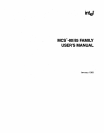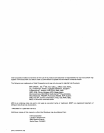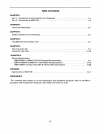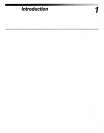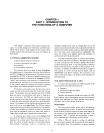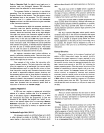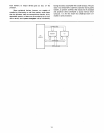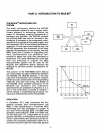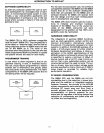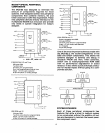
CHAPTER 1
PART
1:
INTRODUCTION
TO
THE FUNCTIONS OF A COMPUTER
This
chapter
introduces
certain
basic
computer
con-
cepts.
It provides
background
information
and
definitions
which
will be useful
in
later
chapters
of
this
manual.
Those
already
familiar
with
computers
may
skip this material,
at
their
option.
A TYPICAL COMPUTER SYSTEM
A typical digital
computer
consists
of:
a)
A
central
processor
unit
(CPU)
b)
A
memory
c)
I
nput/output
(I/O)
ports
The
memory
serves as a place
to
store
Instructions,
the
coded
pieces of
information
that
direct
the
activities of
the
CPU,
and
Data,
the
coded
pieces
of
information
that
are
processed by
the
CPU. A
group
of
logically related instruc-
tions
stored
in
memory
is
referred
to
as a Program.
The
CPU
"reads"
each
instruction
from
memory
in
a logically deter-
mined
sequence,
and
uses it
to
initiate processing
actions.
If
the
program
sequence
is
coherent
and
logical, processing
the
program will
produce
intelligible
and
useful results.
The
memory
is
also used
to
store
the
data
to
be manip-
ulated,
as well as
the
instructions
that
direct
that
manipu-
lation.
The
program
must
be organized such
that
the
CPU
does
not
read a
non-instruction
word
when
it
expects
to
see an
instruction.
The
CPU
can
rapidly access
any
data
stored
in
memory;
but
often
the
memory
is
not
large
enough
to
store
the
entire
data
bank
required
for
a particular appli-
cation.
The
problem
can be resolved by providing
the
com-
puter
with
one
or
more
Input
Ports.
The
CPU can address
these
ports
and
input
the
data
contained
there.
The
addition
of
input
ports
enables
the
computer
to
receive
information
from
external
equipment
(such as a
paper
tape
reader
or
floppy
disk)
at
high rates
of
speed
and
in large volumes.
A
computer
also requires
one
or
more
Output
Ports
that
permit
the
CPU
to
communicate
the
result
of
its pro-
cessing
to
the
outside
world.
The
output
may
go
to
a dis-
play,
for
use by a
human
operator,
to
a peripheral device
that
produces
"hard-copy,"
such as a line-printer,
to
a
1-1
peripheral storage device, such
as
a
floppy
disk unit,
or
the
output
may
constitute
process
control
signals
that
direct
the
operations
of
another
system,
such as an
automated
assembly
line. Like
input
ports,
output
ports
are
addressable.
The
input
and
output
ports
together
permit
the
processor
to
communicate
with
the
outside
world.
The
CPU unifies
the
system. It
controls
the
functions
performed
by
the
other
components.
The
CPU
must
be able
to
fetch
instructions
from
memory,
decode
their
binary
contents
and
execute
them.
It
must also be
able
to
reference
memory
and
I/O
ports
as
necessary
in
the
execution
of
in-
structions.
In
addition,
the
CPU
should
be
able
to
recognize
and
respond
to
certain
external
control
signals, such as
INTERRUPT
and
WAIT requests.
The
functional
units
within
a CPU
that
enable it
to
perform
these
functions
are
described below.
THE ARCHITECTURE OF A
CPU
A
typical
central processor
unit
(CPU)
consists
of
the
following
interconnected
functional
units:
• Registers
•
Arithmetic/Logic
Unit (ALU)
•
Control
Circuitry
Registers are
temporary
storage
units
within
the
CPU.
Some
registers, such as
the
program
counter
and
instruction
register, have
dedicated
uses.
Other
registers, such as
the
ac-
cumulator,
are
for
more
general
purpose
use.
Accumu lator:
The
accumulator
usually
stores
one
of
the
operands
to
be
manipulated
by
the
ALU. A
typical
instruction
might
direct
the
ALU
to
add
the
contents
of
some
other
register
to
the
contents
of
the
accumulator
and
store
the
result in
the
accumulator
itself.
In
general,
the
accumulator
is
both
a
source
(operand)
and
a
destination
(result) register.
Often
a CPU will include a
number
of
additional
general
purpose
registers
that
can be used
to
store
operands
or
intermediate
data.
The
availabil ity
of
general
purpose




